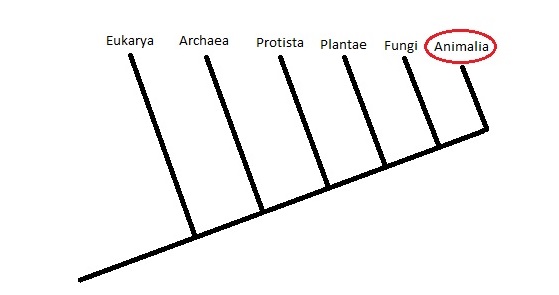Classification
Domain: Opisthocante
This domain contanis organisms that are characterized by having a lifestage form that is unicellular and motile, with one rear-mounted flagellum. A common example of this is a sperm cell. (Encyclopedia of Life: Opisthokonta 2014).
Kingdom: Animalia
This kingdom is characterized by being eukaryotic, multicellular, heterotrophic organism. To be heterotrophic means that you rely on ingesting other organisms to produce energy to perform cellular functions. Members of this group also lack rigid cell walls, which separates them from the plants. Animal bodies are made up of specialized tissues that perform certain tasks throughout the body. (Animal Diversity Web: Animalia 2014).

This is a phylogenetic tree of the six
recognized kingdoms of life. This tree shows the evolutioanary
relationship of the kingdom Animalia to the other five kingdoms. The
Animalia kingdom is indicated by a red circle.
Phylum: Chordata
The Chordates are characterized by a structure called a notochord. In humans (and Pocket Gophers), this is called the brainstem. It is a part of the central nervous system and usually runs along the middle of the ventral surface of the body. It is normally stiff and provides support for locomotion. Members of this phylum are also characterized by bilateral body symmetry, bony or cartilaginous endoskeletons, and tails. (Animal Diversity Web:Chordata 2014)
Class: Mammalia
Members of this class are characterized by having hair at some point in their development, mammary glands, and highly specialized teeth. They give birth to live young, and nurse them with milk produced in their mammary glands. They are usually endothermic, “warm blooded” animals, live in a variety of climates and eat a variety of foods. (Animal Diversity Web: Mammalia 2014).

This image is a phylogentic tree of the
Mammalia class. This tree shows the evolutionary relationship of the
Rodentia order compared to all other orders within Mammalia. The
Rodentia order is number 75.
Order: Rodentia
This is one of the biggest orders in the mammalian phylum with
over 2000 species and 30 families, comprising over 40% of the
mammalian population. They vary greatly in size, habitat, and diet,
but they are all characterized by a dentition that is highly
specialized for gnawing their food. (Animal Diversity Web: Rodentia
2014).
Family: Geomyidae
This family is comprised of only 5 genera and 35 species, all of which live in North and Central America. Its members have been called “fossorial”, meaning that they spend most of their lives underground. Their bodies are specifically modified for digging and burrowing, with short bodies, long toes and claws, short tails, and thin fur. They also have huge incisors and streamlined skulls that facilitate digging. Sometimes called “pocket gophers”, this name refers to the fur lined pockets in their cheeks. (Animal Diversity Web: Geomyidae 2014).
Genus: Thomomys
These are referred to as “western pocket gophers” due to their habitation zone of Southwest America and Northwest Central America. (Animal Diversity Web: Classification 2014). They also are characterized by large incisors that lack frontal grooves (Animal Diversity Web: Thomomys bottae 2014).
This is an image of a pocket gopher with
its characteristic cheek pouches filled.
Species: Thomomys bottae
This species of pocket gopher ranges from 11.5 to 30 cm in length, with a tail that is usually 4 to 9.5 cm long. There is considerable sexual dimorphism in the species, with males being much bigger than females. Males usually weigh around 141g, while females usually weigh around 90g. They also have short, smooth fur and live around 4.8 years. They eat mainly roots and tubers, and live in the American Southwest and the Northwest of Central America. (Animal Diversity Web: Thomomys bottae 2014)
In addition, there are an estimated 195 subspecies of Thomomys bottae across the regions of California, Oregon, Nevada, Utah, Arizona, New Mexico, Colorado, Texas, Baja California, Baja California Sur, Sonora, Chihuahua, Coahuila, and Sinaloa (Jones and Baxter 2004).
